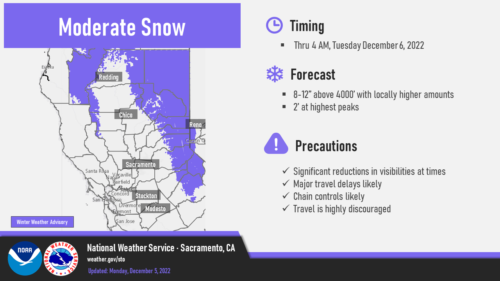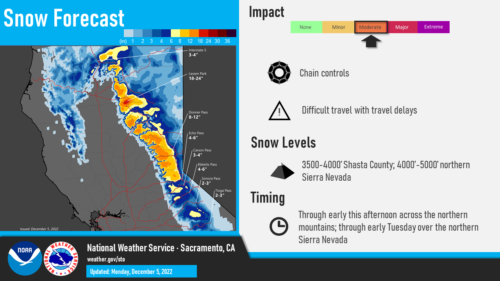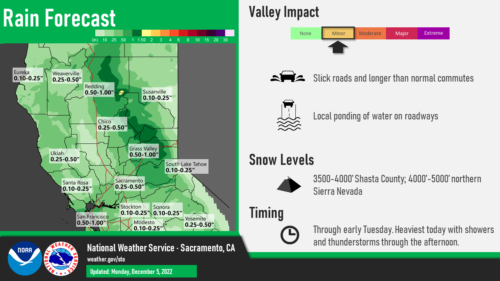On the calendar today …
- WEBINAR: Planning and Funding Climate Resilient California Coastal Infrastructure from 2pm to 3pm. Nossaman’s Shant Boyajian, Liz Klebaner and Ben Rubin discuss state climate resiliency and environmental justice policies relating to coastal transportation and water infrastructure projects and available funding for such projects under the Inflation Reduction Act of 2022. The discussion will be moderated by Nossaman’s Mary Lynn Coffee. Click here to register.
In California water news today …
Sacramento River winter-run salmon face worst year ever
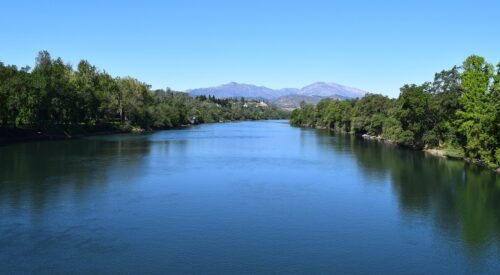
“Salmon that spawn in the Sacramento River in the Redding area are enduring the lowest survival rate on record this year. About 149,000 young winter-run chinook salmon have made it from Redding to Red Bluff this year on their annual trek to the Pacific Ocean, according to data from the University of Washington’s School of Aquatic and Fishery Sciences. In an average year, about 1.3 million of the winter-run salmon would be counted near the former Red Bluff Diversion Dam. This is the second-straight year the number of winter-run salmon migrating down the Sacramento River to the ocean has been very low, according to the National Oceanic and Atmospheric Administration. … ” Read more from the Redding Record-Searchlight here: Sacramento River winter-run salmon face worst year ever
These Imperial Valley farmers want to pay more for their Colorado River water
 “Alex Jack says he’s not charged enough for the water he uses at his Imperial Valley farm. Because the Colorado River water shared by him and his neighboring farmers who make up the vast agricultural economy in the middle of the desert is so cheap, he says, farmers have little incentive to conserve. Jack, though, spends a lot of money to save water through a huge system of irrigation hoses that push water to the root of his Little Gem lettuce plants, drop by drop. The cost to run his 3,200-acre ranch is astronomical for the area, reaching upwards of $1 million a week during the busy season to power and pay for what functions like his own water district, circulating used water back to the top of his fields and storing excess in a private reservoir. “Everything I do is to be a better farmer,” Jack, 64, said. “If I happen to conserve water in the process, that’s great. But they’re subsidizing the people that aren’t conserving water … It’s like politicians giving away free ice cream to everybody, then everyone is happy.” … ” Read more from the Voice of San Diego here: These Imperial Valley farmers want to pay more for their Colorado River water
“Alex Jack says he’s not charged enough for the water he uses at his Imperial Valley farm. Because the Colorado River water shared by him and his neighboring farmers who make up the vast agricultural economy in the middle of the desert is so cheap, he says, farmers have little incentive to conserve. Jack, though, spends a lot of money to save water through a huge system of irrigation hoses that push water to the root of his Little Gem lettuce plants, drop by drop. The cost to run his 3,200-acre ranch is astronomical for the area, reaching upwards of $1 million a week during the busy season to power and pay for what functions like his own water district, circulating used water back to the top of his fields and storing excess in a private reservoir. “Everything I do is to be a better farmer,” Jack, 64, said. “If I happen to conserve water in the process, that’s great. But they’re subsidizing the people that aren’t conserving water … It’s like politicians giving away free ice cream to everybody, then everyone is happy.” … ” Read more from the Voice of San Diego here: These Imperial Valley farmers want to pay more for their Colorado River water
DRIED UP: In California, desalination offers only partial solution to growing drought
“As water in the Western U.S. becomes an increasingly rare commodity, the driest states are grasping at solutions for an even drier future — investing heavily in technologies to maximize the conservation, and creation, of the region’s most precious resource. With more than a thousand miles of Pacific Ocean coastline, California appears to have access to a wellspring that other arid states lack. The technology to transform that unlimited sea supply into potable drinking water has existed for decades, through a process called desalination. Yet while two new desalination plants have received approvals in the past couple months, California’s coast isn’t exactly teeming with such facilities. That’s because the technology, which is both expensive and energy intensive, can leave behind a mammoth-sized footprint on both surrounding communities and marine life, even as it helps quench the thirst of a parched citizenry. … ” Read more from The Hill via Yahoo News here: DRIED UP: In California, desalination offers only partial solution to growing drought
Waves of precipitation keep coming for West Coast
“Most along the West Coast have been no stranger to unsettled weather as of late, with frequent rounds of cold rain near the coasts, heavy snow at higher elevations, and strong winds ripping through many regions. After yet another storm slammed into the coast this weekend, AccuWeather forecasters say more of the same will be in store through the week, with more opportunities for beneficial rainfall up and down the coast. Those along the Interstate 5 corridor did not need to wait long for more rain to arrive, with many spots already seeing rain early Sunday morning. The culprit was a large area of low pressure lingering just offshore, helping direct moisture-rich air toward the coast. The heaviest rain is likely to be directed into the northern half of California, however precipitation is likely to spread as far north as Washington, and as far south as the Los Angeles area, according to the latest forecasts. ... ” Read more from AccuWeather here: Waves of precipitation keep coming for West Coast
Tom Birmingham: Reflections on Westlands
Don Wright writes, “Formed in 1952 the largest water district in the nation is more than 600,000 acre Westlands Water District on the westside of the San Joaquin Valley. The longest serving General Manager at WWD has been Tom Birmingham, who is retiring at the end of December after 22-years in that position. I had the opportunity to sit and have an online talk with Birmingham on a recent, dark Friday afternoon as the rain began to fall.What struck me most was how relaxed Birmingham was away from the often high pressured public view of a public agency trying to supply water to its constituents. The interview was supposed to be for a half hour but went on for an hour and a half. It’s often observed those who depend on irrigation love the rain as much as ducks, so the rain brought about an improved mood for all of us. … ” Read more from Water Wrights here: Tom Birmingham; Reflections on Westlands
Managing source water for maximum benefit in a challenging climate
“In drought-prone northern California, limited water resources, private water rights allocations, and inefficient transport and use of water resources causes tension between freshwater conservation and private landownership. In the face of a changing climate, drought curtailments will likely become more frequent, ratchetting stress on all water users. From an engineering perspective, efficiently managing water rights as arid landscapes become drier and less predictable will be essential to preservation of working landscapes and the environment. Water purchases and leases are a common tool for securing water rights for environmental purposes. California recently considered a budget proposal to allocate $1.5 billion to buy-back private agricultural water rights to mitigate drought and support ecological uses. However, water right purchases can be incredibly expensive, and understanding which water rights are most likely to achieve maximal environmental benefit is vital for optimized management. Especially in coldwater habitats, the quality of water sources included in buy-backs will determine success of such efforts. ... ” Read more from the California Water Blog here: Managing source water for maximum benefit in a challenging climate
A photographic tour of California’s marine protected areas
“From the waves crashing around the Santa Monica Pier to seabirds flying high above the Monterey Bay National Marine Sanctuary, California’s coastline is a place we go to relax, play, and be at one with nature. And we’re not alone: California’s coast is a hotspot for ocean life, including breaching whales, charismatic sea otters and darting seabirds. Many migratory marine animals find refuge in California’s nutrient rich waters during their long journeys up and down the North American coast and even around the world. As stewards of this ocean bounty, California has led the nation in setting aside special habitats off our coast and creating refuges for ocean life. As our network of marine protected areas (MPA) — like state parks in the ocean — turns 10 years old, we want to highlight how these areas can help endangered species, restore fish populations and create resilience in the face of unforeseen disasters. Join us on a tour of these remarkable places. … ” Read more at Environment America here: A photographic tour of California’s marine protected areas
How will climate change affect California’s ski industry?
 “The impacts of climate change are widespread and one industry that will certainly be affected is California’s ski industry. While warming temperatures are unquestionably a major concern associated with climate change, Mike Reitzell, President of Ski California, pointed to another symptom of a warming climate here in California. “The number one thing has been variability and volatility, you know, that each season we come into, you really don’t know what you’re gonna get. I mean, last season being a real perfect example,” said Reitzell. … ” Read more from Channel 10 here: How will climate change affect California’s ski industry?
“The impacts of climate change are widespread and one industry that will certainly be affected is California’s ski industry. While warming temperatures are unquestionably a major concern associated with climate change, Mike Reitzell, President of Ski California, pointed to another symptom of a warming climate here in California. “The number one thing has been variability and volatility, you know, that each season we come into, you really don’t know what you’re gonna get. I mean, last season being a real perfect example,” said Reitzell. … ” Read more from Channel 10 here: How will climate change affect California’s ski industry?
California seeks Native American help after years of environmental abuse
“Native people had been living in California’s Owens Valley since time immemorial when the first permanent settler arrived in 1860. More followed, and within a year, fences erected around homesteads blocked access to traditional sources of food and water. The Indigenous Paiute who crossed fence lines were shot, a sudden clash between a culture built on partnership with nature and one striving to profit from what the natural world had to offer. This pattern was repeated over and over as Americans pushed westward to fulfill the country’s “manifest destiny” and natural resources were harnessed to grow its capitalist economy. Today, ecological systems altered and damaged by human activity pose threats to communities and their economies. The need for smarter approaches to natural resource management and climate mitigation has never been greater, and many in government believe that Indigenous stewardship practices deserve a bigger place in their plans. … ” Read more from Governing here: California seeks Native American help after years of environmental abuse
Wildfires: Burning through state budgets
“Wildfires in the United States have become more catastrophic and expensive in recent years, with the U.S. Department of the Interior and the U.S. Forest Service nearly doubling their combined spending on wildfire management in the last decade.1 Wildfire management consists of preparing for, fighting, recovering from, and reducing the risk of fires. To execute these activities, states, localities, the federal government, and Tribes, as well as nongovernment entities such as nonprofit organizations and private property owners, participate in a complex system of responsibilities and funding dictated by land ownership and an interconnected set of cooperative agreements. As more frequent and severe fires drive up public spending, policymakers at all levels of government are faced with decisions about how to pay for the diverse array of interventions required to deal with them. ... ” Read more from the Pew Charitable Trust here: Wildfires: Burning through state budgets
In regional water news and commentary today …
SACRAMENTO VALLEY
Tehama County project receives Wildlife Conservation Board funding
“A Tehama County project is among the Wildlife Conservation Board’s (WCB) selection of approved projects to be funded through $24.46 million in grants to help restore and protect fish and wildlife habitat throughout California. Some of the 16 approved projects will benefit fish and wildlife – including some endangered species, while others will provide public access to important natural resources. Several projects will also demonstrate the importance of protecting working landscapes that integrate economic, social and environmental stewardship practices beneficial to the environment, landowners and the local community. … ” Read more from the Colusa Sun-Herald here: Tehama County project receives Wildlife Conservation Board funding
Impressive rainfall totals from Northern California storm — how much did Sacramento get?
“The capital region got more than its fair share of precipitation from this weekend’s winter storm, the second to rake across Northern California in less than a week. Most areas in the southern Sacramento Valley received 1.5 inches of rain or more in the 24-hour period from midnight Saturday to midnight Sunday. “(Saturday) we had a good amount of rain across Northern California. We’re expecting another round tonight and into tomorrow,” National Weather Service forecaster Chelsea Peters said about 4 p.m. Sunday just as another band of heavy rain packing thunderclaps moved quickly across south Sacramento County. … ” Read more from the Sacramento Bee here: Impressive rainfall totals from Northern California storm — how much did Sacramento get?
BAY AREA
Thunderstorms possible for parts of the Bay Area Monday, with more rain on the way
“The Bay Area had an exciting weekend, with rain in the region and snow piling up in the Sierra — but the weather isn’t over as we’re left with the remnants of this low-pressure system. The region will see another day of showers and a chance of thunderstorms on Monday, with the precipitation coming to an end Tuesday morning. A drier and colder weather pattern will follow, setting up temperatures that could drop close to freezing over the next few mornings, in some locales. … ” Read more from the San Francisco Chronicle here: Thunderstorms possible for parts of the Bay Area Monday, with more rain on the way
SEE ALSO: More rain to hit the Bay Area while fresh powder falls over the Sierra Nevada, from the San Jose Mercury News
Marin picks up more rain as system moves through region
“Parts of Marin County received another inch of rain over the weekend as a line of storms moves through the region. The 48-hour rain totals ending around 7:30 p.m. Sunday included 1.07 inches on Mount Tamalpais and 0.98 inches in Kentfield, according to the National Weather Service. Other totals included 0.53 inches in Sausalito, 0.47 inches at the county fairgrounds in San Rafael, 0.40 inches in Tiburon and about a quarter-inch in Novato. The storms that ushered in a chilly, soggy start to December should continue to move across Northern California early this week, offering more chances for rain in the Bay Area and a fresh coat of powder over the Sierra Nevada. … ” Read more from the Marin Independent Journal here: Marin picks up more rain as system moves through region
Marin sea-level defense projects bolstered by state funding
“The California State Coastal Conservancy is set to invest $3.5 million to begin planning an expansion of sea-level rise and shoreline erosion defense projects around Marin and San Francisco Bay. The projects will use natural fortifications such as oyster beds, sand beds, beaches and marshes instead of sea walls and rip-rap. The agency’s board unanimously decided to move forward on Thursday. Planners will draw on lessons learned from existing projects, such as artificial oyster reefs and beach improvements near San Rafael, to prepare for 10 more projects around the region’s bayfront. … ” Read more from the Marin Independent Journal here: Marin sea-level defense projects bolstered by state funding
A massive, floating swimming pool on San Francisco Bay? Here’s where a developer wants to build it
“Ever wished you could swim on the bay without actually immersing yourself in the frigid, murky water? A new proposal would turn an old pier on the San Francisco waterfront into the Bay Area’s first public floating pool, where guests could swim laps, play water polo or lounge in a hot tub while soaking up a view of the Bay Bridge. The plan also includes offices, shops and apartments — and for those who do prefer cold salt water, a protected cove for open water swimming, kayaking and paddle boarding. Proponents say the project could provide much-needed opportunities for locals to become more confident swimmers, in a city that is surrounded on three sides by water but has limited access to pools. But some neighbors already have raised objections to the project’s proposed residential towers and questioned the need for a pool. And developers have years of hurdles to jump through before they can even break ground. ... ” Read more from the San Jose Mercury News here: A massive, floating swimming pool on San Francisco Bay? Here’s where a developer wants to build it
State Parks fully reopens Brannan Island State Recreation Area
“California State Parks has full reopened of Brannan Island State Recreation Area after moving to reduced operations earlier this year. All areas of the park will opened to the public Thursday. The public may begin booking camping reservations starting Jan. 1. Park Delta Bay will operate the state recreation area, which includes day-use areas, a boat launch ramp and campground sites. Brannan Island is a maze of waterways through the Sacramento-San Joaquin Delta located northeast of the San Francisco Bay in the Suisun Marsh. The park unit has countless islands and marshes with many wildlife habitats and opportunities for recreation, including boating and swimming. … ” Read more from the Daily Republic here: State Parks fully reopens Brannan Island State Recreation Area
Solano County Water Agency directors on path to address legislative platform
“The Solano County Water Agency will reorganize its board officers and executive committee as well as address its legislative platform when the directors meet Thursday. The in-person meeting is set for 6 p.m. in the Berryessa Room of the agency’s office, 810 Vaca Valley Parkway, Suite 203. No virtual attendance is possible. … ” Read more from the Daily Republic here: Solano County Water Agency directors on path to address legislative platform
Biogas: Not letting waste go to waste, San Jose wastewater facilities turn methane into power
“At a sprawling sewage treatment plant in north San Jose, engineers are slowly perfecting the ideal temperature for a smelly mixture of bacteria and human waste as the stew churns inside four massive air-tight cauldrons. The plant, the largest wastewater treatment facility west of the Mississippi to produce water clean enough to be discharged into a sensitive ecosystem like San Francisco Bay, is experimenting with new heat-loving bacteria that excel at turning poop into compost and energy — harnessing the power of dangerous greenhouse gases. “It’s like making bread or making yogurt,” said civil engineer Mariana Chavez-Vazquez, who oversaw the renovation of the cauldrons. The bacteria “need to be happy. They need to be a certain temperature. If you put in something that they don’t like, they will go sour.” … ” Read more from the San Jose Mercury News here: Biogas: Not letting waste go to waste, San Jose wastewater facilities turn methane into power
SAN JOAQUIN VALLEY
HABs in Stockton: Perspective from a resident scientist
Spencer Fern, Science Coordinator with Restore the Delta, writes, “Over the past few years, Stockton has been plagued with a blue-green nuisance known as harmful algal blooms (HABs). As the Science Coordinator for Restore the Delta, I run Restore the Delta’s HABs monitoring program to help fill in data gaps for government agencies related to Stockton waterways. Growing up on the Delta I was able to travel by boat to many locations throughout the region. I also attended a high school in downtown Stockton where our physical education classes were always around the water at Mcleod Lake. I never wanted to jump in the water at the Stockton waterfront because of how dirty and foul-smelling the waters are. This dread of the Delta’s unclean water was reinforced by the opinions of many people on those boating and recreating adventures. When running miles up and down the catwalk near Mcleod Lake in downtown Stockton (part of the urban Delta), I’d catch bad odors coming from the water. I never thought more about it because I was accustomed to these conditions. It wasn’t until college that I learned about HABs and realized that those foul odors I grew up smelling were likely HABs. As students, we were never warned about how dangerous they could be. … ” Continue reading at Restore the Delta here: HABs in Stockton: Perspective from a resident scientist
IMPERIAL/COACHELLA VALLEYS
Commentary: One solution to the Salton Sea crisis: Build an underground tunnel to the Pacific Ocean
John Treichler, a retired aerospace engineer based in Banning, writes, “Due to the western U.S. drought and increased water use, there is a declining amount of water available in the Colorado River to maintain agriculture, enable the lithium recovery industry, or to restore the Salton Sea. … Importation of water from a new source is needed to maintain the valuable agriculture in the area, enable the lithium industry and restore the Salton Sea to its previous recreational status. … the Pacific Ocean, 70 air miles distant is the only feasible source of new water: Via underground tunnel. No pumping required. The only roadblock: Coastal Commission permitting. It can be done! … ” Read more from the Salton Sea here: Commentary: One solution to the Salton Sea crisis: Build an underground tunnel to the Pacific Ocean
Salton Sea public health disaster gets a $250 million ‘shot in the arm’
“Last week, the federal government announced it will spend a quarter of a billion dollars over four years to clean up what remains of the Salton Sea, a lake in southern California that has been shrinking due to climate change-driven drought. For decades, communities living near the sea have been afflicted by health problems caused by algae blooms and dust storms spurred by wind kicking up drying sediment from the sea’s ever-widening shores. The government’s new plan aims to help remediate some of those health impacts while simultaneously encouraging farms in the region to reduce their reliance on water from the Colorado River. The $250 million will come from $4 billion earmarked for drought funding in the Inflation Reduction Act, the climate and energy security bill passed by Democrats and signed by President Joe Biden in August. … ” Read more from the Grist here: Salton Sea public health disaster gets a $250 million ‘shot in the arm’
Along the Colorado River …
Double dead pool on the Colorado River
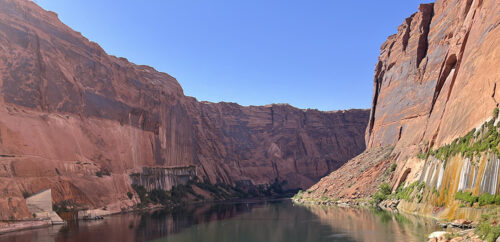 Jon Fleck writes, “The Bureau of Reclamation folks haven’t posted the slides yet from last week’s Supplemental Environmental Impact Statement briefings. In the meantime, some of us in the Colorado River nerd world have been passing around our screenshotted copies like some sort of precious mimeographed ’60s ‘zine. It was a remarkable affair. Buried in the tables and graphs was a sobering message: If we are to take climate change seriously, we need to be prepared for the possibility of driving Lake Mead to “dead pool” in order to protect the structural integrity of Glen Canyon Dam; driving Lake Powell below the critical power pool threshold, where Reclamation is forced to use Glen Canyon Dam’s dicey outlet works, in order to protect Lake Mead from reaching dead pool … ” Continue reading at the Inkstain blog here: Double dead pool on the Colorado River
Jon Fleck writes, “The Bureau of Reclamation folks haven’t posted the slides yet from last week’s Supplemental Environmental Impact Statement briefings. In the meantime, some of us in the Colorado River nerd world have been passing around our screenshotted copies like some sort of precious mimeographed ’60s ‘zine. It was a remarkable affair. Buried in the tables and graphs was a sobering message: If we are to take climate change seriously, we need to be prepared for the possibility of driving Lake Mead to “dead pool” in order to protect the structural integrity of Glen Canyon Dam; driving Lake Powell below the critical power pool threshold, where Reclamation is forced to use Glen Canyon Dam’s dicey outlet works, in order to protect Lake Mead from reaching dead pool … ” Continue reading at the Inkstain blog here: Double dead pool on the Colorado River
Feds announce plan for massive cuts in Colorado River deliveries
“The Bureau of Reclamation is for the first time legally signaling its intent to make major cutbacks in water deliveries from Lake Powell to Lake Mead and the Lower River Basin to protect the reservoirs that are on the edge of collapse. In online presentations last week, the bureau said it’s working through a formal process that could lead to cutting deliveries from Powell by 2 million to 3 million acre-feet annually and possibly more. That could happen if states in the Lower River Basin — Arizona, California and Nevada — can’t reach agreement by Jan. 31 on how to slice their take from the river, the agency said. The bureau didn’t specify when cuts would begin or how they would be divided among states, saying those questions will be answered later. But “it means that we’re looking at unprecedented reductions in supplies. There’s just no way you can slice and dice this any other way than that, especially if you’re using water from the CAP (Central Arizona Project),” said Cynthia Campbell, Phoenix’s water resources management advisor. ... ” Read more from the Arizona Daily Star here: Feds announce plan for massive cuts in Colorado River deliveries
U.S. West’s water management system on edge of collapse, expert says
“The lifeblood of the West, the Colorado River, is slowly dying, its flows that nourish 40 million people in seven states shrinking without respite. The planet keeps heating up, and the reservoirs that feed the canals bringing water to lettuce and alfalfa fields and to faucets, toilets and lawns keep falling. The state governments charged with the river’s management are locked in a standoff over how to wean themselves from decades-long dependence on this water that borders on addiction. That dependence has been enshrined into the U.S. legal system through treaties, regulations, compacts, court decisions and statutes that collectively add up to the Law of the River. … ” Read more from the Arizona Daily Star here: U.S. West’s water management system on edge of collapse, expert says
Lake levels lead to adjustments by Reclamation
“The Bureau of Reclamation has begun monthly operational adjustments with reduced releases from Glen Canyon Dam under the Drought Response Operations Agreement. The adjusted releases are designed to help protect critical elevations at Lake Powell until the spring runoff materializes. The monthly adjustments will hold back 523,000 acre-feet of water in Lake Powell from December 2022 through April 2023 when inflow to the reservoir is low. The same amount of water (523,000 acre-feet) will then be added to releases to Lake Mead between June and September after the spring runoff occurs. … ” Read more from Lake Powell Life here: Lake levels lead to adjustments by Reclamation
Thornton has plenty of water — it’s just in the wrong place. And that’s a very Colorado story.
“Thornton needs water. Developers are scrapping homebuilding projects out of fears that the city can’t guarantee them a water tap in the next few years. Thornton has water. It’s waiting here at a headgate where the Cache la Poudre’s pristine high Rockies snowmelt is siphoned off into a farm ditch and reservoir network, 70 miles north of Thornton in western Larimer County. Thornton secretly started buying the water off farmland far from home in 1986, and now owns about 19,000 acres — and the accompanying water shares — across Larimer and Weld counties. Thornton needs a way to get its priceless water. … ” Read more from the Colorado Sun here: Thornton has plenty of water — it’s just in the wrong place. And that’s a very Colorado story.
In national water news today …
How rising sea levels could damage building foundations
“Storm surge. Tidal flooding. Erosion. Some impacts of sea-level rise are easy to see, but others are hidden. “What happens when the sea level rises to the built environment from underneath?” says Hussam Mahmoud of Colorado State University. He explains that as seas rise, the underground water table in coastal areas rises too. And it gets saltier. Over time, that saltwater can seep through cracks in a building’s foundation and corrode its steel supports. … ” Read more from Yale Climate Connections here: How rising sea levels could damage building foundations
More news and commentary in the weekend edition …
In California water news this weekend …
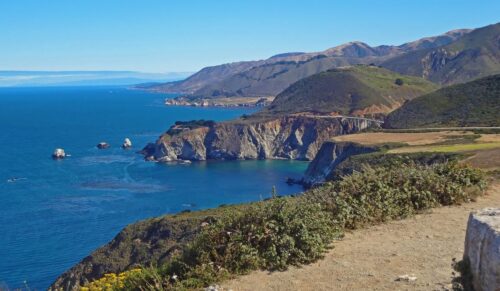 More unsettled weather takes aim at West Coast
More unsettled weather takes aim at West Coast- Desalination: Cal Am faces tough road ahead to meet Coastal Commission conditions
- VIDEO: Westlands longtime GM Birmingham believes it’s right time to retire, claims if he stayed it would have created conflict and distraction
- California’s almond groves shrink as water supply dwindles
- Extreme drought means meager portions for California water agencies
- California Farm Bureau responds to initial 5% allocation of water from state
- In-person public comment meeting in Hood, CA will focus on Delta Tunnel project EIR
- ‘We have never had this bad a frost before’: April frost cut down this year’s Christmas tree crop in the Sierra
- Is the American West finally ready to kill the lawn?
- State accepts applications for money to restore eroded beaches
- Reclamation makes operational adjustments from Lake Powell to protect low level critical elevations
- Western water leaders talk local solutions amid Colorado River crisis
- Congress passes bill to block rail strike, ensuring access to water treatment chemicals
- And more …
Also on Maven’s Notebook today …
NOTICE: Temporary Suspension of Some Curtailments in the Delta Watershed


